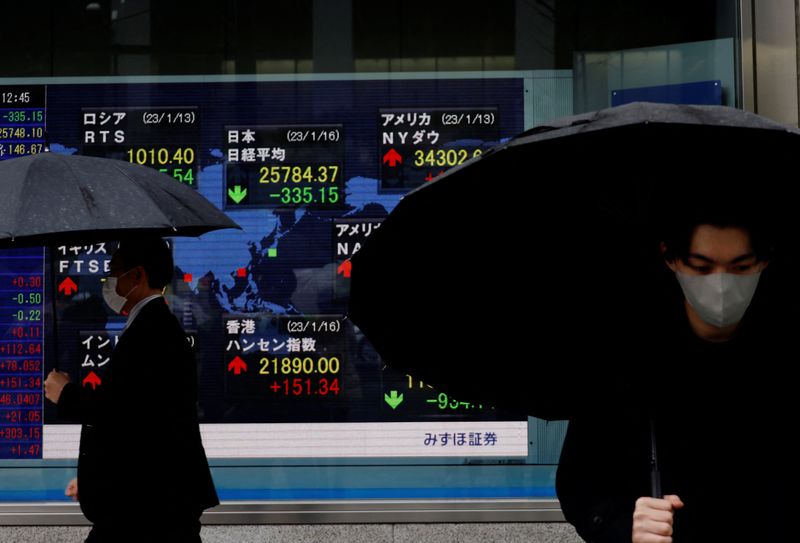 © Reuters. Men walk past an electric board displaying Nikkei and other countries' indexes outside a brokerage in Tokyo, Japan January 16, 2023. The characters on the screen reads,"government bonds". REUTERS/Kim Kyung-Hoon
© Reuters. Men walk past an electric board displaying Nikkei and other countries' indexes outside a brokerage in Tokyo, Japan January 16, 2023. The characters on the screen reads,"government bonds". REUTERS/Kim Kyung-Hoon
By Sinéad Carew
NEW YORK (Reuters) - The S&P 500 and the Nasdaq finished in the red on Friday and oil prices settled lower after U.S. economic data prompted bets that the Federal Reserve would get more aggressive with interest rate hikes to battle stubborn inflation.
Friday's data showed a year-over-year 0.8% increase in export prices versus expectations for a decline of 0.2%. On Thursday, data showed accelerating monthly producer prices in January and lower-than-expected unemployment benefits claims for last week.
Along with hawkish comments from two Fed officials on Thursday, and Goldman Sachs (NYSE:GS) and Bank of America (NYSE:BAC) forecasts for three more Fed rate hikes this year, the data led some investors to start bracing for more tightening, according to Shawn Cruz, head trading strategist at TD Ameritrade in Chicago.
"The thing that kicked this off yesterday was the producer prices coming in elevated. It means one or two things. Companies are going to pass the costs on to consumers, causing more inflation, or absorb these higher costs, which would result in lower profitability. Either way it's not good," said Cruz.
While Fed rate hikes can help curb inflation, the U.S. central bank has less control over import prices.
"That shows that global demand is coming back on line. That might make it a little bit more difficult to bring inflation down," Cruz said.
Traders have raised their bets on how far they see the Fed hiking in recent sessions, and are now pricing in a peak at around 5.3% in September.
The Dow Jones Industrial Average rose 129.84 points, or 0.39%, to 33,826.69, the S&P 500 lost 11.32 points, or 0.28%, to 4,079.09 and the Nasdaq Composite dropped 68.56 points, or 0.58%, to 11,787.27.
The pan-European STOXX 600 index lost 0.20% and MSCI's gauge of stocks across the globe shed 0.38%. Emerging market stocks lost 1.01%.
U.S. Treasury yields eased a bit on Friday after the 10-year yield earlier hit a three-month high, as the market placed greater odds that the Federal would keep interest rates higher for longer in its fight against persistent inflation.
Benchmark 10-year notes were down 3 basis points to 3.813%, from 3.843% late on Thursday. The 2-year note was last was down 0.2 basis points to yield 4.6169%.
The gap between yields on two-year and 10-year notes US2US10=TWEB was last inverted at minus 79.7 bps, from Tuesday's peak inversion of minus 91.3 bps. The inversion signals market expectations for a coming recession.
"I do think there's still more capacity for the Fed to come off as more hawkish, and that should be most detrimental for the front end of the curve," said Ben Jeffrey, U.S. rates strategist at BMO Capital Markets in New York. "At that point we would expect the curve will start to move steeper."
The dollar index, which measures the U.S. currency against a basket of major currencies, earlier hit a six-week high as traders ramped up bets for Fed rate hikes.
However, the greenback lost ground as the session wore on with the euro up 0.23% to $1.0693.
The Japanese yen weakened 0.16% versus the greenback at 134.16 per dollar, while Sterling was last trading at $1.2044, up 0.43% on the day.
Oil futures fell sharply on Friday and registered a weekly decline, pressured by signs of ample supply along with concerns of more Fed interest rate hikes, which could weigh on demand.
U.S. crude settled down 2.74% at $76.34 per barrel and Brent finished at $83.00, down 2.51% on the day.
Gold prices were up very slightly for the day but down for the week due to by a stronger dollar and rising bond yields.
Spot gold added 0.2% to $1,841.94 an ounce. U.S. gold futures gained 0.01% to $1,842.20 an ounce.
Bitcoin last rose 4.95% to $24,685.00, below Thursday's session peak of $25,270. Thursday's session high was bitcoin's highest since June 2022, but the crypto currency retreated and closed Thursday's session down 3.5%.

